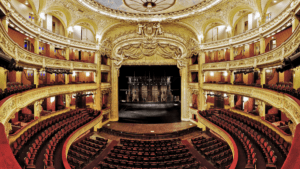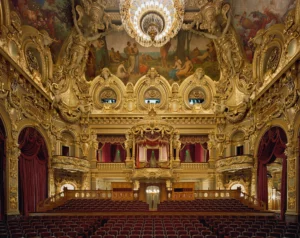Introduction
Sigmund Freud, often referred to as the father of psychoanalysis, has left an indelible mark on the field of psychology and the study of the human mind. His theories, while controversial, have shaped the way we understand human behavior, dreams, and the unconscious. Nestled in the heart of Vienna lies a tribute to this iconic figure – the Sigmund Freud Museum. This museum not only offers a glimpse into Freud’s life and work but also stands as a testament to his enduring legacy.
History of the Museum
The Sigmund Freud Museum is located in Freud’s former home and practice, a place where he spent a significant portion of his life. This historic building, situated at Berggasse 19, has witnessed the birth of many of Freud’s groundbreaking theories.
The house stands as a symbol of Freud’s journey, from his early days as a young doctor to his evolution as the pioneer of psychoanalysis.
Berggasse 19 is not just an address; it’s a landmark in the world of psychology. The significance of this location is manifold:
It was here that Freud penned some of his most influential works.
The rooms have echoed with discussions, debates, and sessions that have shaped the course of psychoanalytic thought.
The museum, through its exhibits, transports visitors back in time, allowing them to walk in Freud’s footsteps and experience the ambiance of early 20th-century Vienna.
Visiting the museum is akin to embarking on a journey through the annals of psychoanalytic history, providing a unique opportunity to delve deep into the life and times of one of the most influential figures of the modern era. For those keen on understanding the evolution of psychoanalysis and Freud’s contribution to it, this resource offers a comprehensive overview.
Features of the Museum
The Sigmund Freud Museum has undergone a significant transformation, making it a must-visit for both enthusiasts of Freud’s work and history buffs alike.
Newly Renovated and Enlarged Museum: The museum has been revamped to accommodate more exhibits and provide a more immersive experience for visitors. The renovations have ensured that the museum retains its historical charm while integrating modern amenities.
Exhibitions: The museum boasts a range of exhibitions, both permanent and temporary.
Permanent exhibitions delve deep into Freud’s life, his groundbreaking theories, and his contributions to psychoanalysis.
Temporary exhibitions, on the other hand, offer insights into various facets of Freud’s life, his contemporaries, and the broader context of his work. These exhibitions often collaborate with other historic sites in Europe to bring unique artifacts and displays to the museum.
Accessible Rooms: Visitors can walk through the very rooms where the Freud family lived and worked. These rooms have been preserved meticulously to give visitors a genuine feel of the era and the environment in which Freud formulated his theories.
Artifacts and Furniture: The museum houses a plethora of new objects, artifacts, and furniture, some of which have never been displayed before. These items provide a tangible connection to Freud’s life and times.
Visitor Experience
A visit to the Sigmund Freud Museum is not just about viewing exhibits; it’s about immersing oneself in the world of one of the greatest minds in history.
Duration: It’s recommended to set aside 2-3 hours for the visit. This allows visitors to explore the museum at a leisurely pace, soaking in the rich history and ambiance.
Tours and Experiences: The museum offers guided tours, providing deeper insights into Freud’s life, his work, and the significance of the artifacts on display. These tours are often led by experts in the field of psychoanalysis, ensuring an enriching experience. Additionally, there are interactive experiences designed to engage visitors and provide a hands-on understanding of Freud’s theories.
Top Ways to Experience the Museum: Apart from the regular museum tour, visitors can:
Attend workshops and seminars.
Explore the museum’s library, which houses a vast collection of books related to Freud and psychoanalysis.
Visit nearby attractions in Vienna, further enhancing their understanding of the era. For those interested in exploring more of Vienna’s historic sites, this guide offers a comprehensive overview.
A visit to the Sigmund Freud Museum is more than just a walk through exhibits; it’s a journey into the world of a genius.
Duration: For those planning a visit, it’s recommended to allocate 2-3 hours. This ensures ample time to immerse oneself in the rich history and ambiance of the museum.
Tours and Experiences: The museum offers a plethora of guided tours and interactive experiences.
These tours delve deep into Freud’s life, his groundbreaking theories, and the significance of the artifacts on display.
Led by experts in psychoanalysis, these tours promise an enriching and enlightening experience. For a broader context of Freud’s work and its impact, this resource offers a comprehensive overview.
Top Ways to Experience the Museum:
Freud’s Life in Vienna: Freud spent a significant portion of his life in Vienna, and the city played a pivotal role in shaping his theories. His family life, interactions with contemporaries, and daily routines offer a unique perspective into the man behind the legend.
The Serviten Quarter: The Freud family resided in the Serviten Quarter, a historic neighborhood in Vienna.
This area is not just significant for its association with Freud but also for its rich history and cultural significance.
The quarter, with its quaint streets and historic buildings, provides a glimpse into Vienna’s past and the environment that influenced Freud’s work.
Old Jewish Cemetery in Seegasse: The Freud family, being of Jewish descent, had deep ties to Vienna’s Jewish community.
The old Jewish cemetery in Seegasse is a testament to the city’s Jewish heritage.
This cemetery, one of the oldest in Vienna, holds historical significance and is a poignant reminder of the city’s diverse cultural fabric.
Reviews and Visitor Feedback
The Sigmund Freud Museum in Vienna has garnered attention from visitors worldwide, each coming with their own expectations and leaving with unique experiences.
Positive Reviews and Experiences:
Many visitors laud the museum for its comprehensive portrayal of Freud’s life and work.
The interactive exhibits and guided tours have been particularly appreciated for providing in-depth insights into Freud’s theories and methodologies.
The ambiance of the museum, which transports visitors back to Freud’s era, has been a highlight for many. For a broader understanding of Freud’s impact on psychology, this resource offers valuable insights.
Constructive Feedback and Areas of Improvement:
Some visitors have suggested more interactive and multimedia exhibits to cater to younger audiences.
There have been suggestions to include more translations for non-German speaking visitors.
Comparison with Other Freud Museums:
The Freud Museum in London is another notable institution dedicated to Freud’s life and work. While the Vienna museum focuses more on Freud’s life in the city and his foundational theories, the London museum delves into his later life and his family’s experiences after fleeing Nazi-occupied Austria. Those interested in a comparative experience can explore the Freud Museum London for more details.
FAQs
Why is the museum significant?
The Sigmund Freud Museum stands on the very grounds where Freud lived and worked for many years. It offers a tangible connection to his life, his family, and the birthplace of many of his groundbreaking theories.
How long should one plan to spend at the museum?
It’s recommended to allocate 2-3 hours for a comprehensive experience. However, those keen on delving deep into every exhibit might want to set aside more time.
What unique artifacts can visitors expect to see?
The museum houses numerous personal belongings of Freud, including his original furniture, personal letters, and photographs. Additionally, there are rare manuscripts and first editions of his works, providing a unique insight into his thought process and evolution as a psychoanalyst.




